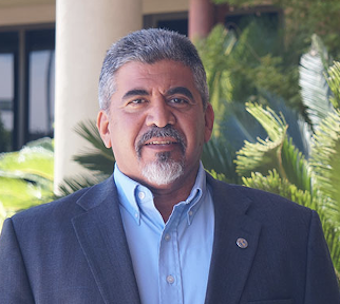BLOG: Using fallowed ag land for solar farms opens training, job opportunities for local workers

Written by Chuck Riojas
In all the talk about the San Joaquin Valley’s groundwater restrictions and resulting loss of agriculture, it’s important to consider how transitioning from farming operations to clean-energy production creates construction job opportunities for thousands of area workers.
The mandate to meet state clean energy goals by 2045 — and the loss of farmland due to groundwater restrictions under the 2014 Sustainable Groundwater Management Act — have opened the door to a vast solar resource that can keep land economically productive and local people employed in good jobs for the long term.
But current law makes these land transitions cumbersome and complicated, hampering the region’s potential to become a solar energy hub. If corrected, the switch from unusable farmland to low-water-use, clean energy projects would generate billions in tax revenue and labor income while lowering household electric bills and cleaning up our air.
A bill passed by the California Assembly in June aims to do just that by modernizing language in the 1965 Williamson Act, a law designed to preserve farmland. The act incentivizes landowners to maintain agricultural production but requires them to clear numerous legal and other hurdles to allow for “solar-use easements” when the land can no longer be used for farming.
The bill neither replaces nor overhauls the Williamson Act, but it safeguards agriculture in the long term, allowing for land to return to agricultural use when and if the owner secures water and wishes to resume farming.
Specifically, Assembly Bill 1156 by Assemblymember Buffy Wicks would expand the authorized uses of the land under the easement to include solar energy, storage and related renewable energy facilities. The bill also revises the conditions under which land subject to a Williamson Act contract may be subject to a solar-use easement.
If adopted, these changes are projected to create 22,000 jobs annually, generate over $7 billion in tax revenue and produce $34 billion in labor income, according to the California Legacy Partnership.
Wicks’ new legislation deserves support from anyone who wants to see well-paying, career-building opportunities in the region, enabling struggling areas to adapt in an innovative and sustainable way.
As baby boomers retire and demand for skilled labor increases, training the next generation of workers is essential, particularly in our region. Fortunately, Fresno and other San Joaquin Valley counties are well-positioned to supply workers for these and other projects on the horizon. The Fresno, Madera, Tulare and Kings Building Trades Council and its affiliated unions, for example, offer apprenticeships to prepare workers for solar and other clean-energy production.
As a long-time electrician who benefited from joint labor management apprenticeships, I know these programs can lead to rewarding careers, and I want to see those same opportunities available for underserved communities in our area.
Construction of solar production facilities requires installers, electricians, operations and maintenance specialists. We have a ready and eager workforce to train for and fill these positions.
The Scarlet Solar Project west-southwest of Tranquility created more than 100 construction jobs and yielded nearly $2 million to landowners in 2024, as well as $133 million for local governments and $13 million in vendor spending and donations in the area in 2024.
Nearby, the Luna Valley 200-megawatt solar facility was built on a 1,300-acre site that had been used to grow alfalfa for livestock, a portion of which is now fallow. The project, which employed 150 electrical workers, is expected to generate enough reliable electricity to power more than 80,000 homes every year.
Helping our region achieve lower emissions, provide clean energy sources and create well-paying jobs and careers for our workforce is a clear win for Fresno and every agricultural community in California.
Chuck Riojas is a long-serving member of the California Workforce Development Board, Fresno Regional Workforce Development Board and Workforce Development Board of Madera County, and a lifelong advocate for skilled labor and workforce advancement. He has been a member of the International Brotherhood of Electrical Workers Local 100 since 1987.






